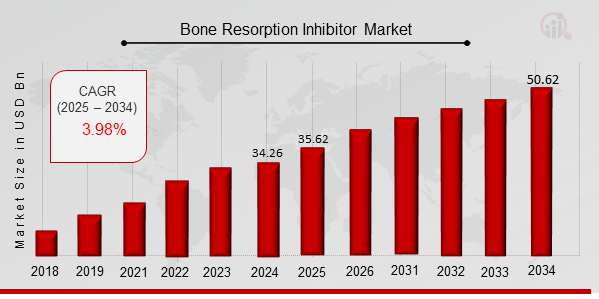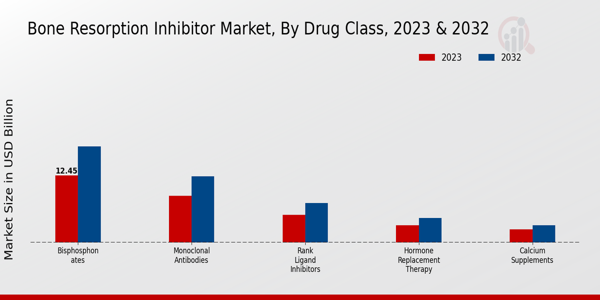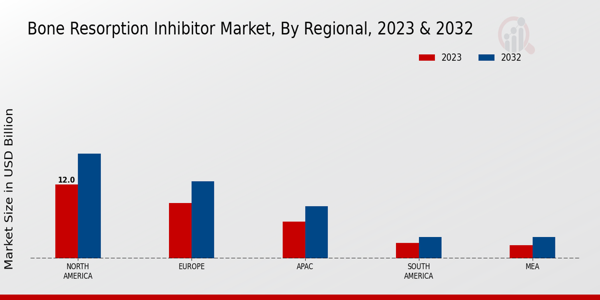Bone Resorption Inhibitor Market Overview:
As per MRFR analysis, the Bone Resorption Inhibitor Market Size was estimated at 34.26 (USD Billion) in 2024. The Bone Resorption Inhibitor Market Industry is expected to grow from 35.62 (USD Billion) in 2025 to 50.62 (USD Billion) till 2034, at a CAGR (growth rate) is expected to be around 3.98% during the forecast period (2025 - 2034).
Key Bone Resorption Inhibitor Market Trends Highlighted
The Global Bone Resorption Inhibitor Market is seeing significant advancements primarily driven by the increasing prevalence of osteoporosis and other bone-related disorders. The aging population and rising awareness of bone health are pushing demand for these inhibitors as more individuals seek effective treatments to prevent bone loss. Additionally, the growing emphasis on preventive healthcare and advancements in medical technology contribute to the rise in market interest and investment in bone health therapies. Enhanced research and development plays a crucial role in discovering new and more effective bone resorption inhibitors, further solidifying this market's growth potential.There are abundant opportunities for the market to explore, especially in untapped regions where awareness and access to treatment are still developing. Innovative product development tailored to patient needs presents a promising avenue for companies looking to expand their offerings. Collaborations between pharmaceutical companies and research institutions can foster breakthroughs in treatment methods, addressing challenges associated with existing drugs. The rise of telemedicine also creates a unique opportunity for patient outreach and education regarding bone health, leading to increased patient engagement in their treatment plans. In recent times, there has been a noticeable trend towards personalized medicine, with treatments being tailored to individual genetic profiles.This shift is helping to optimize treatment efficacy and minimize side effects, enhancing the overall patient experience. An increasing focus on developing combination therapies is also emerging, where bone resorption inhibitors are used alongside other treatments to improve outcomes. Moreover, there's a growing trend in the use of new delivery methods, such as injectables and implants, offering more convenience and better adherence to treatment protocols. Overall, as awareness and innovative solutions grow, the market for bone resorption inhibitors is poised for sustained growth.

Source: Primary Research, Secondary Research, MRFR Database and Analyst Review
Bone Resorption Inhibitor Market Drivers
Increasing Prevalence of Osteoporosis and Other Bone Disorders
The growing prevalence of osteoporosis and various bone disorders is one of the most significant drivers of the Global Bone Resorption Inhibitor Market Industry. As the global population ages, the incidence of osteoporosis, particularly among postmenopausal women, is on the rise. This condition not only affects the quality of life but also increases the risk of fractures, leading to higher healthcare costs and burdens. According to epidemiological studies, a significant percentage of women over the age of 50 will experience osteoporotic fractures during their lifetime.As the demographic landscape continues to shift toward an older population, there is a corresponding increase in the demand for effective treatments. Bone resorption inhibitors, such as bisphosphonates and monoclonal antibodies, have demonstrated efficacy in reducing the risk of fractures in these patients. These medications work by inhibiting the activity of osteoclasts, the cells responsible for bone resorption, thereby maintaining or increasing bone mass and strength.The heightened awareness around the consequences of untreated osteoporosis has led to increased screening and treatment initiation, providing a robust growth avenue for the Global Bone Resorption Inhibitor Market Industry. Furthermore, governments and healthcare organizations are launching initiatives aimed at educating the public about bone health, further boosting market demand. This proactive approach is expected to significantly contribute to the expansion of the market in the coming years as more patients become aware of available treatment options and seek medical advice for their bone health needs.
Advancements in Pharmaceutical Research and Development
The Global Bone Resorption Inhibitor Market Industry is benefitting significantly from advancements in pharmaceutical research and development. Ongoing innovation in drug formulation and delivery mechanisms has led to the creation of newer and more effective bone resorption inhibitors. These advancements include the development of selective RANKL inhibitors and oral formulations that improve patient compliance. Researchers are focused on identifying new molecular targets and pathways involved in bone metabolism, which has resulted in the discovery of novel treatment options.This ongoing evolution in the pharmaceutical landscape not only enhances treatment efficacy but also enables healthcare providers to better tailor therapies to individual patient needs, thereby boosting market growth.
Rising Awareness of Bone Health
There is a growing awareness regarding bone health among consumers and healthcare professionals, significantly influencing the growth of the Global Bone Resorption Inhibitor Market Industry. Increasing educational campaigns about the importance of managing bone health, especially in older populations, have made individuals more conscious of their lifestyle choices. Awareness initiatives underscore the necessity of early diagnosis and intervention for bone-related conditions.This shift in focus encourages individuals to seek medical advice and consider preventive or therapeutic treatment options, which is likely to result in an increase in the adoption of bone resorption inhibitors. Furthermore, healthcare providers are emphasizing the promotion of a healthy diet, physical activity, and regular check-ups to monitor bone density, thereby contributing positively to the growth trajectory of the market.
Bone Resorption Inhibitor Market Segment Insights:
Bone Resorption Inhibitor Market Drug Class Insights
The Global Bone Resorption Inhibitor Market, particularly in the Drug Class segment, represents a vital area in addressing conditions related to bone health. In 2023, the market stood at an impressive valuation of 31.68 USD Billion, showcasing a strong demand for treatments aimed at inhibiting bone resorption. A closer examination reveals that Bisphosphonates significantly dominate this segment, accounting for 12.45 USD Billion, a majority holding due to their widespread use in managing osteoporosis and other skeletal disorders. Following closely, Monoclonal Antibodies also play a crucial role in therapy, valued at 8.62 USD Billion in 2023, reflecting the innovative approaches being adopted to target bone remodeling with precision.The market for Rank Ligand Inhibitors has garnered attention as well, specifically valued at 5.06 USD Billion, emphasizing the growing recognition of its effectiveness in managing bone loss by inhibiting RANKL, a key factor in osteoclast activation. Meanwhile, Hormone Replacement Therapy, contributing 3.18 USD Billion, remains relevant for treatment options, especially in women undergoing menopause, reinforcing its significance within the market. Lastly, Calcium Supplements, while the least dominant with a valuation of 2.37 USD Billion, still provide foundational support in promoting bone density and overall health, thereby holding a relevant position in the Global Bone Resorption Inhibitor Market landscape.Overall, the segmentation highlights distinct roles and growing trends within the market, driven by advancements in treatment efficacy and an increased understanding of bone health dynamics, indicating several opportunities for growth across various therapeutic options.

Source: Primary Research, Secondary Research, MRFR Database and Analyst Review
Bone Resorption Inhibitor Market Application Insights
The Global Bone Resorption Inhibitor Market has shown a steady valuation, reaching 31.68 USD Billion in 2023, emphasizing the crucial role of application in addressing critical health issues. Focusing on applications, the market encompasses various medical conditions, including Osteoporosis, which has a significant prevalence worldwide, thus driving the demand for effective treatments. Additionally, the market sees notable contributions from Cancer and Bone Metastases, where bone health is often compromised due to malignancies. Paget's Disease presents another area of concern, as effective management is essential for maintaining quality of life, making it a significant driver in the market.Hypercalcemia further adds to the market's diversity, reflecting the need for interventions in complex medical cases. Overall, the segmentation of the Global Bone Resorption Inhibitor Market demonstrates a comprehensive landscape where each application area plays a vital role in market growth, driven by increasing incidence rates and the need for targeted therapies. The combination of these factors contributes to the ongoing advancements within the market, making it an essential segment within the larger industry context.
Bone Resorption Inhibitor Market Formulation Insights
The Global Bone Resorption Inhibitor Market is expected to reach a valuation of 31.68 billion USD in 2023 and is projected to grow steadily by 2032. The formulation segment plays a vital role in this market, as it includes various delivery methods essential for effective treatment options. In the realm of formulations, the categorization includes oral, injectable, intravenous, transdermal, and topical forms, each serving distinct patient needs. Oral formulations dominate due to their convenient administration, appealing to patient preference for non-invasive options.Injectable formulations are also significant, often providing rapid action and higher bioavailability, making them suitable for patients requiring quick therapeutic effects. Intravenous options cater to severe cases, allowing for immediate relief through direct bloodstream access. Transdermal and topical formulations have gained traction owing to their targeted delivery mechanisms, minimizing systemic effects and enhancing patient compliance. Overall, the Global Bone Resorption Inhibitor Market data suggests a promising growth outlook, driven by evolving treatment paradigms and an increasing prevalence of bone-related disorders, with market growth sustained by rising healthcare expenditures and an aging population.
Bone Resorption Inhibitor Market End User Insights
The Global Bone Resorption Inhibitor Market has shown a steady progression, with the overall market valued at 31.68 billion USD in 2023. As health systems evolve, the End User segment has gained notable priorities, comprising Hospitals, Clinics, Home Care Settings, and Pharmacies that play critical roles in enhancing patient care. Hospitals dominate this segment, benefiting from advanced treatment technologies and a larger patient base, providing a crucial environment for the administration of bone resorption inhibitors. Clinics also contribute significantly by enabling targeted treatments and follow-up care.The rising trend towards home care settings reflects a shift towards patient-centered approaches, increasing accessibility and convenience for patients requiring long-term management of bone-related conditions. Pharmacies hold a vital role in medication distribution and patient education, ensuring adherence to treatment regimens. As the Global Bone Resorption Inhibitor Market continues to grow, the demand for comprehensive services from these various End Users underscores their importance in mitigating bone diseases effectively. The market growth is supported by an increasing aging population and rising awareness of osteoporosis treatments, both of which present opportunities for further advancements and innovations in the industry.
Bone Resorption Inhibitor Market Regional Insights
The Regional segmentation of the Global Bone Resorption Inhibitor Market reveals significant insights into market dynamics across various regions. North America leads the market, valued at 12.0 USD Billion in 2023, and is projected to reach 17.0 USD Billion by 2032, highlighting its majority holding due to advanced healthcare infrastructure and technology adoption. Europe follows closely, with a valuation of 9.0 USD Billion in 2023, expected to grow to 12.5 USD Billion, signifying its substantial investment in bone health innovations. The APAC region, valued at 6.0 USD Billion in 2023, is anticipated to grow to 8.5 USD Billion, driven by increasing awareness of bone disorders and rising healthcare expenditures.In South America, the market stands at 2.5 USD Billion, reaching an estimated 3.5 USD Billion, reflecting a growing demand despite economic challenges. Lastly, the MEA region holds a valuation of 2.18 USD Billion in 2023, with a potential increase to 3.5 USD Billion, showcasing opportunities due to improving healthcare access and rising patient population. Each region's growth is influenced by factors such as demographics, health policies, and economic conditions, making the Global Bone Resorption Inhibitor Market data crucial for understanding evolving trends and market growth.

Source: Primary Research, Secondary Research, MRFR Database and Analyst Review
Bone Resorption Inhibitor Market Key Players and Competitive Insights:
The Global Bone Resorption Inhibitor Market is characterized by a diverse range of participants, each vying for supremacy in the growing landscape of osteoporosis and related conditions. With an increasing geriatric population and a rising awareness of bone health, the market is witnessing heightened competition. Several companies are investing in research and development to bring innovative products to market, striving to meet the specific needs of patients while adhering to regulatory standards. Companies are also focusing on strategic partnerships, collaborations, and mergers and acquisitions to enhance their market presence and expand their product portfolios. As the market evolves, competitive differentiation will increasingly rely on scientific advancements, pricing strategies, and effective marketing campaigns to capture consumer interest and loyalty.Eli Lilly has established a strong position in the Global Bone Resorption Inhibitor Market with its innovative products and a robust pipeline aimed at treating osteoporosis and conditions associated with bone metabolism. The company's emphasis on research and development has resulted in the launch of several cutting-edge therapies that are well-received in the market. Additionally, Eli Lilly's well-established distribution networks and profound market penetration enhance its accessibility to healthcare providers and patients alike. The company leverages various marketing strategies to effectively communicate the benefits of its bone resorption inhibitors, focusing on education about osteoporosis management and the importance of bone health. Furthermore, Eli Lilly invests significantly in clinical studies to validate the efficacy and safety of its products, thereby reinforcing its credibility and trust among patients and healthcare professionals.Teva Pharmaceutical Industries is a key player in the Global Bone Resorption Inhibitor Market, recognized for its commitment to providing affordable treatment options while maintaining high-quality standards. The company has developed a range of generic and specialty medications that cater to the needs of patients with bone-related diseases. One of Teva's strengths is its extensive global reach, allowing it to serve a wide customer base effectively. The company also emphasizes the importance of research and development, focusing on innovative formulation strategies and cost-effective alternatives to existing therapies. Teva's strategic initiatives include collaborations with healthcare providers and organizations to enhance patient access to its bone resorption inhibitors, demonstrating its dedication to improving therapy adherence and overall patient outcomes. Through these efforts, Teva continues to position itself as a formidable competitor in the Global Bone Resorption Inhibitor Market, ensuring that it meets the growing demand for effective and affordable solutions in bone health management.
Key Companies in the Bone Resorption Inhibitor Market Include:
- Eli Lilly
- Teva Pharmaceutical Industries
- Roche
- UCB
- GSK
- Novartis
- Pfizer
- Mylan
- Horizon Therapeutics
- Merck
- Regeneron Pharmaceuticals
- Amgen
- Bristol-Myers Squibb
- Sanofi
- AstraZeneca
Bone Resorption Inhibitor Market Industry Developments
Recent developments in the Global Bone Resorption Inhibitor Market point towards active engagement and growth among key players such as Eli Lilly, Teva Pharmaceutical Industries, Roche, and Novartis. Eli Lilly has reported advancements in its osteoporosis therapies, which are poised to enhance patient outcomes significantly. Teva Pharmaceutical Industries is focusing on expanding its product portfolio, particularly in biosimilars, as the oncology segment gains traction. Roche has launched initiatives to improve patient access and increase awareness regarding bone health, reflecting a shift towards preventive measures. Meanwhile, GSK and Pfizer are working collaboratively to address the unmet needs in bone-related disorders, which is essential for driving market growth. Recent merger and acquisition activity includes AstraZeneca's acquisition of a prominent biotech specializing in bone health, aiming to strengthen its position in the market. Furthermore, as these companies focus on innovation and expanding therapeutic applications, their market valuations are experiencing upward movements, positively impacting the overall Global Bone Resorption Inhibitor Market as stakeholders look to capitalize on emerging opportunities in this evolving landscape.
Bone Resorption Inhibitor Market Segmentation Insights
- Bone Resorption Inhibitor Market Drug Class Outlook
- Bisphosphonates
- Monoclonal Antibodies
- Rank Ligand Inhibitors
- Hormone Replacement Therapy
- Calcium Supplements
- Bone Resorption Inhibitor Market Application Outlook
- Osteoporosis
- Cancer
- Paget's Disease
- Bone Metastases
- Hypercalcemia
- Bone Resorption Inhibitor Market Formulation Outlook
- Oral
- Injectable
- Intravenous
- Transdermal
- Topical
- Bone Resorption Inhibitor Market End User Outlook
- Hospitals
- Clinics
- Home Care Settings
- Pharmacies
- Bone Resorption Inhibitor Market Regional Outlook
- North America
- Europe
- South America
- Asia Pacific
- Middle East and Africa
| Report Attribute/Metric |
Details |
|
Market Size 2024
|
34.26 (USD Billion)
|
|
Market Size 2025
|
35.62 (USD Billion)
|
|
Market Size 2034
|
50.62 (USD Billion)
|
|
Compound Annual Growth Rate (CAGR)
|
3.98 % (2025 - 2034)
|
|
Report Coverage
|
Revenue Forecast, Competitive Landscape, Growth Factors, and Trends
|
|
Base Year
|
2024
|
|
Market Forecast Period
|
2025 - 2034
|
|
Historical Data
|
2020 - 2024
|
| Market Forecast Units |
USD Billion |
| Key Companies Profiled |
Eli Lilly, Teva Pharmaceutical Industries, Roche, UCB, GSK, Novartis, Pfizer, Mylan, Horizon Therapeutics, Merck, Regeneron Pharmaceuticals, Amgen, Bristol-Myers Squibb, Sanofi, AstraZeneca |
| Segments Covered |
Drug Class, Application, Formulation, End User, Regional |
| Key Market Opportunities |
Aging population increase, Rising osteoporosis prevalence, Advances in drug formulations, Growing awareness of bone health, Expanding applications in oncology |
| Key Market Dynamics |
Aging population increase, Rising osteoporosis prevalence, Advancements in drug formulations, Growing healthcare awareness, Government health initiatives |
| Countries Covered |
North America, Europe, APAC, South America, MEA |
Frequently Asked Questions (FAQ) :
The Global Bone Resorption Inhibitor Market is expected to be valued at 50.62 USD Billion by 2034.
The market is expected to grow at a CAGR of 3.98% from 2025 to 2034.
North America is projected to have the largest market share, valued at 17.0 USD Billion in 2032.
The market size for Bisphosphonates was valued at 12.45 USD Billion in 2023 and is projected to reach 17.8 USD Billion in 2032.
Major players include Eli Lilly, Teva Pharmaceutical Industries, Roche, UCB, and GSK among others.
The market value for Monoclonal Antibodies is projected to be 12.24 USD Billion by 2032.
The expected market size for the APAC region is 8.5 USD Billion by 2032.
Key growth drivers include an aging population and increasing prevalence of bone-related disorders.

















